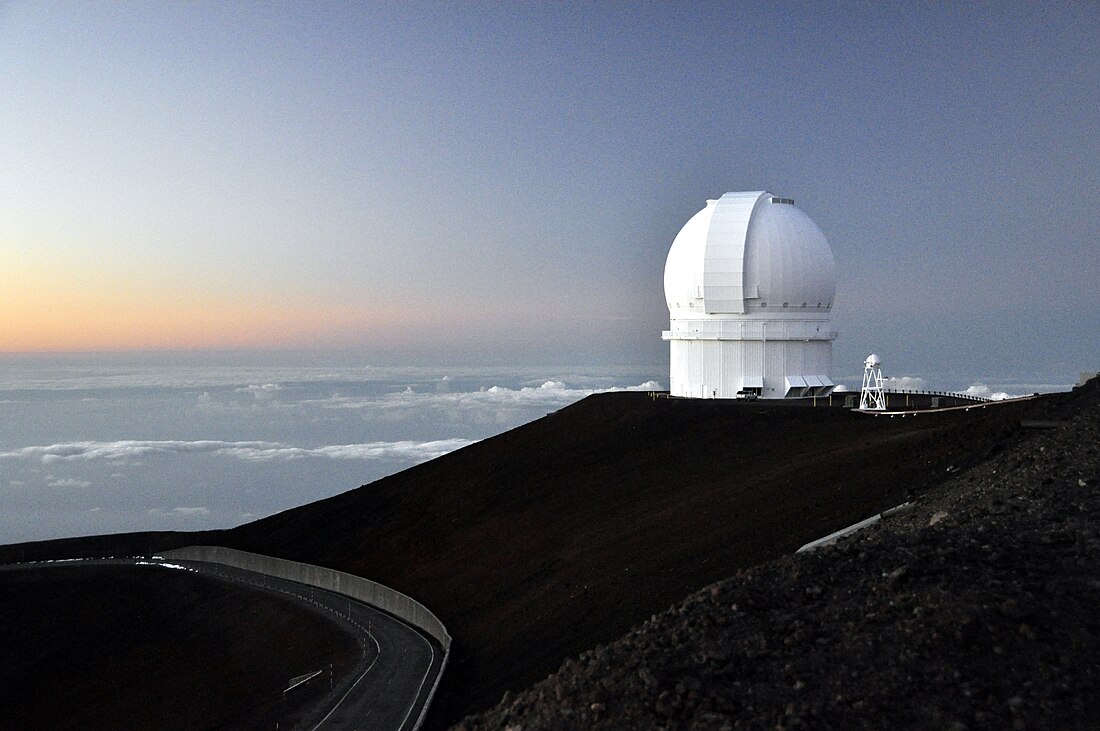Top Qs
Timeline
Chat
Perspective
Canada–France–Hawaii Telescope
Astronomical observatory From Wikipedia, the free encyclopedia
Remove ads
The Canada–France–Hawaii Telescope (CFHT) is located near the summit of Mauna Kea mountain on Hawaii's Big Island at an altitude of 4,204 meters (13,793 feet), part of the Mauna Kea Observatory. Operational since 1979,[1] the telescope is a Prime Focus/Cassegrain configuration with a usable aperture diameter of 3.58 metres (11.7 ft).
CFHT is currently considering a refurbishment to the facility in the 2020s. The facility would be reconstructed with a new 11-meter telescope to produce the Maunakea Spectroscopic Explorer, retaining the same base building and infrastructure. First light is expected no earlier than 2029.[citation needed]
Remove ads
Funding
The corporation is bound by a tripartite agreement between the University of Hawaii at Manoa, in the United States, the National Research Council (NRC) in Canada and the Centre National de la Recherche Scientifique (CNRS) in France. CFHT also has partnerships with the National Astronomical Observatory of China (NAOC), the Academia Sinica Institute of Astronomy and Astrophysics (ASIAA) in Taiwan, the National Laboratory of Astrophysics (LNA) in Brazil and the Korea Astronomy and Space Science Institute (KASI) in Korea. The contributions from these associate partners help fund CFHT's future instrumentation. Currently, CFHT observing time is offered to scientists from all the seven countries in the partnership. Astronomers from the European Union can also submit proposals through the Optical Infrared Coordination Network for Astronomy (OPTICON) access program.
Remove ads
Instruments
CFHT currently operates five instruments:
- MegaPrime/MegaCam,[2] a one-square-degree field high-resolution CCD mosaic of 40 CCDs totalling 378 megapixels
- WIRCam (Wide-Field Infrared Camera),[3] an infrared mosaic of 4 detectors totalling 16 megapixels, optimized for the J, H, and K spectral bands[4]
- ESPaDOnS (Echelle SpectroPolarimetric Device for the Observation of Stars at CFHT),[5] an echelle spectrograph/spectropolarimeter
- SITELLE (Spectromètre Imageur à Transformée de Fourier pour l'Etude en Long et en Large de raies d'Emission), a wide-field Fourier transform spectrograph[6]
- SPIRou (Spectropolarimètre Infrarouge), a near-infrared spectropolarimeter[7]
Remove ads
Notable discoveries
In March 2025, astronomers using the CFHT announced the discovery of 128 new moons of Saturn, bringing the gas giant's total number of confirmed satellites to 274.[8][9]
Outreach
CFHT, in collaboration with Coelum Astronomia, maintains a public-outreach website called "Hawaiian Starlight"[10] which offers extremely high-quality versions of CFHT images in various formats including a yearly calendar.
Gallery
This section contains an excessive or unencyclopedic gallery of images. (April 2025) |
 |
 |
 |
 |
See also
References
External links
Wikiwand - on
Seamless Wikipedia browsing. On steroids.
Remove ads


